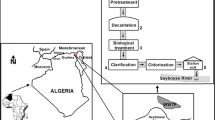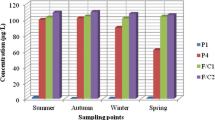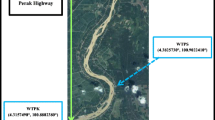Abstract
The genotoxicity of industrial wastewaters from Jajmau (Kanpur), was carried out by Ames Salmonella/microsome test, DNA repair-defective mutants, and Allium cepa anaphase–telophase test. Test samples showed maximum response with TA98 strain with and without metabolic activation. Amberlite resins concentrated wastewater samples were found to be more mutagenic as compared to those of liquid–liquid extracts (hexane and dichloromethane extracts). The damage in the DNA repair defective mutants in the presence of Amberlite resins concentrated water samples were found to be higher to that of liquid–liquid-extracted water samples at the dose level of 20 μl/ml culture. Among all the mutants, polA exhibited maximum decline with test samples. Mitotic index (MI) of root tip meristematic cells of A. cepa treated with 5, 10, 25, 50, and 100 % (v/v) wastewaters were significantly lower than the control. Complementary to the lower levels of MI, the wastewaters showed higher chromosomal aberration levels in all cases investigated.


Similar content being viewed by others
References
Aleem A, Malik A (2005) Genotoxicity of Yamuna River water at Okhla (Delhi), India. Ecotoxicol Environ Saf 61:404–412
Ansari MI, Malik A (2009) Genotoxicity of wastewaters used for irrigation of food crops. Environ Toxicol 24:103–115
APHA (American Public Health Association), American Water Works Association (AWWA), Water Environment Federation (WEF) (1995) Standard methods for the examination of water and wastewater, 19th edn. Washington, DC
Carita R, Marin-Morales MA (2008) Induction of chromosome aberrations in the Allium cepa test system caused by exposure of seeds to industrial effluents contaminated with azo dyes. Chemosphere 72:722–725
Castillo M, Barcelo D, Pereira AS, Aquino Neto FR (1999) Characterization of organic pollutants in industrial effluents by high temperature gas chromatography–mass spectrometry. Trends Anal Chem 18:26–36
Chandra R, Bharagava RN, Kapley A, Purohit HJ (2011) Bacterial diversity, organic pollutants and their metabolites in two aeration lagoons of common effluent treatment plant (CETP) during the degradation and detoxification of tannery wastewater. Bioresour Technol 102:2333–2341
Coureclle J, Hanawalt PC (2001) Participation of recombination proteins in rescue of arrested replication forks in UV-irradiated Escherichia coli need not involve recombination. PNAS 98:8196–8202
Fernandes TCC, Mazzeo DEC, Marin-Morales MA (2007) Mechanism of micronuclei formation in polyploidizated cells of Allium cepa exposed to trifluralin herbicide. Pestic Biochem Physiol 88:252–259
Fiskesjo G (1985) The Allium test as a standard in environmental monitoring. Hereditas 102:99–112
Hartnik T, Norli HR, Eggen T, Breedveld GD (2007) Bioassay-directed identification of toxic organic compounds in creosote-contaminated ground-water. Chemosphere 66:435–443
Junk GA, Richard JJ, Grieser MD, Witiak D, Witiak JL, Arguello MD, Vick R, Svec HJ, Fritz JS, Calder GV (1974) Use of macroreticular resins in the analysis of water for trace organic contaminants. J Chromatogr 99:745–762
Klaunig JE, Kamendulis LM, Hocevar BA (2010) Oxidative stress and oxidative damage in carcinogenesis. Toxicol Pathol 38:96–109
Kool HJ, van Kreijl CF, van Kranen H, de Greef E (1981) The use of XAD-resins for the detection of mutagenic activity in water. I. Studies with surface water. Chemosphere 10:85–98
Lambolez L, Vasseur P, Ferrad JF, Gisbert T (1994) The environmental risks of industrial waste disposal: an experimental approach including acute and chronic toxicity studies. Ecotoxicol Environ Saf 28:317–328
Leme DM, Marin-Morales MA (2008) Chromosome aberration and micronucleus frequencies in Allium cepa cells exposed to petroleum polluted water-a case study. Mutat Res 650:80–86
Leme DM, Marin-Morales MA (2009) Allium cepa test in environmental monitoring: a review on its application. Mutat Res 682:71–81
Liu DH, Jiang WS, Li M (1992) Effects of trivalent and hexavalent chromium on root growth and cell division of Allium cepa. Hereditas 117:23–29
Ma TH, Xu Z, Xu C, McConnell H, Rabago EV, Arreola GA, Zhang H (1995) The improved Allium/Vicia root tip micronucleus assay for clastogenicity of environmental pollutants. Mutat Res 334:185–195
Magdaleno A, Puig A, de Cabo L, Salinas C, Arreghini S, Korol S, Bevilacqua S, López L, Moretton J (2001) Water pollution in an urban Argentine river. Bull Environ Contam Toxicol 67:408–415
Maluszynska J, Juchimiuk J (2005) Plant genotoxicity: a molecular cytogenetic approach in plant bioassays. Arh Hig Rada Toksikol 56:177–184
Maron D, Ames BN (1983) Revised methods for the Salmonella mutagenicity test. Mutat Res 113:173–215
Masood F, Malik A (2013) Cytotoxic and genotoxic potential of tannery waste contaminated soils. Sci Tot Environ 444:153–160
Matsumoto ST, Mantovani MS, Malaguttii MIA, Dias AL, Fonseca IC, Morales MAM (2006) Genotoxicity and mutagenicity of water contaminated with tannery effluents, as evaluated by the micronucleus test and comet assay using the fish Oreochromis niloticus and chromosome aberrations in onion root-tips. Genet Mol Biol 29:148–158
Mikoczy Z, Schutz A, Stromberg U, Hagmar L (1996) Cancer incidence and specific occupational exposures in the Swedish leather tanning industry: a cohort based case control study. Occup Environ Med 53:463–467
Monte Egito LM, das Gracas Medeiros M M, Batistuzzo de Medeiros SR, Agnez-Lima LF (2007) Cytotoxic and genotoxic potential of surface water from the Pitimbu river, northeastern/RN Brazil. Genet Mol Biol 30:435–441
Moore NP (2000) The estrogenic potential of the phthalate esters. Reprod Toxicol 14:183–192
Mortelmans K, Zeiger E (2000) The Ames Salmonella/microsome mutagenicity assay. Mutat Res 455:29–60
Mwinyihija M, Strachan NJC, Dawson J, Meharg A, Killham K (2006) An ecotoxicological approach to assessing the impact of tanning industry effluent on river health. Arch Environ Contam Toxicol 50:316–324
Mwinyihija M (2007) Assessment of anaerobic lagoons efficacy in reducing toxicity levels of tannery effluent in Kenya. Res J Environ Toxicol 1:167–175
Ohe T, Watanabe T, Wakabayashi K (2004) Mutagens in surface waters: a review. Mutat Res 567:109–149
Pagano DA, Zeiger E (1992) Conditions for detecting the mutagenicity of divalent metals in Salmonella typhimurium. Environ Mol Mutagen 19:136–146
Rodrigues MLK, Formoso MLL (2006) Heavy metals in recent sediments and bottom-fish under the influence of tanneries in South Brazil. Water Air Soil Pollut 176:307–327
Seth CS, Misra V, Chauhan LKS, Singh RR (2008) Genotoxicity of cadmium on root meristem cells of Allium cepa: cytogenetic and Comet assay approach. Ecotoxicol Environ Saf 71:711–716
Song Z, Williams CJ, Edyvean RJ (2000) Sedimentation of tannery wastewater. Water Res 34:2171–2176
Tigini V, Giansanti P, Mangiavillano A, Pannocchia A, Varese GC (2011) Evaluation of toxicity, genotoxicity and environmental risk of simulated textile and tannery wastewaters with a battery of biotests. Ecotoxicol Environ Saf 74:866–873
Unyayar S, Celik A, Cekic FO, Gozel A (2006) Cadmium-induced genotoxicity, cytotoxicity and lipid peroxidation in Allium sativum and Vicia faba. Mutagenesis 21:77–81
Vargas VMF, Motta VEP, Henriques JAP (1993) Mutagenic activity detected by the Ames test in River water under the influence of petrochemical industries. Mutat Res 319:31–45
Vargas VMF, Guidobono RR, Jordao C, Henriques JAP (1995) Use of two short- term tests to evaluate the genotoxicity of River water treated with different concentration/extraction procedures. Mutat Res 343:31–52
White PA, Rasmussen JB (1998) The genotoxic hazards of domestic wastes in surface waters. Mutat Res 410:223–236
Wilcox P, Williamson S (1986) Mutagenic activity of concentrated drinking water samples. Environ Health Perspect 69:141–149
Zahm SH, Ward MH, Blair A (1997) Pesticides and cancer. Occup Med State Art Rev 12:269–289
Acknowledgments
FM is thankful to the UGC, New Delhi for financial assistance in the form of Maulana Azad National Fellowship. AM is thankful to the Department of Biotechnology, Government of India, New Delhi, for DBT CREST award during the preparation of the manuscript. The authors are also thankful to Sophisticated Analytical Instrument Facility (SAIF) IIT, Bombay, for carrying out GC-MS analysis.
Author information
Authors and Affiliations
Corresponding author
Additional information
Responsible editor: Robert Duran
Rights and permissions
About this article
Cite this article
Masood, F., Malik, A. Mutagenicity and genotoxicity assessment of industrial wastewaters. Environ Sci Pollut Res 20, 7386–7397 (2013). https://doi.org/10.1007/s11356-013-1756-0
Received:
Accepted:
Published:
Issue Date:
DOI: https://doi.org/10.1007/s11356-013-1756-0




